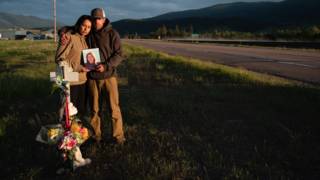
By Amy Goodman & Denis Moynihan
Paha Sapa is the traditional name the Lakota people give the sacred center of their universe. The region is also known as The Black Hills, in South Dakota, home of Mount Rushmore, itself named after a gold rush lawyer and speculator. The Mount Rushmore Monument features the sculpted heads of four U.S. presidents — Washington, Jefferson, Lincoln and Theodore Roosevelt — blasted out of the ancient granite between 1927 and 1941 by 400 workers, directed by sculptor Gutzon Borglum. Earlier, he was recruited by the Daughters of the Confederacy to carve the huge, Stone Mountain memorial to Confederate leaders in Georgia. While he left that project in a dispute, Stone Mountain allowed Borglum to hone his mountain carving skills, enabling the Rushmore monument. Borglum was close to the Ku Klux Klan and was likely a member.
On Friday July 3rd, kicking off this weekend’s Independence Day holiday, President Donald Trump is rallying at Mount Rushmore with a fighter jet flyover and fireworks, which are banned in the area due to extreme forest fire potential. With 7,500 people expected, South Dakota Governor Kristi Noem, a staunch Trump ally, declared, “we won’t be social distancing.” Face masks will not be required. This “comeback” event occurs as the U.S. suffers an explosion of COVID-19 cases and a charged, national debate on how to deal with statues and symbols enshrining systemic racism.
Tribal governments and activist organizations in the region are calling for the event’s cancellation. “The lands on which that mountain is carved and the lands he’s about to visit belong to the Great Sioux nation,” Oglala Sioux president Julian Bear Runner told The Guardian. “He doesn’t have permission from its original sovereign owners to enter the territory at this time…It’s going to cause an uproar if he comes here.”
Trump’s ill-timed, inflammatory spectacle is reminiscent of his failed June rally in Tulsa, Oklahoma, which was scheduled to fall on Juneteenth, a day that celebrates the end of slavery in 1865, at a venue not far from the scene of one of the worst massacres of African Africans in U.S. history, the Tulsa race massacre of 1921. Under pressure, Trump moved his rally to June 20th, the day after Juneteenth. One million people preregistered for the rally, but local police estimated that only 6,500 actually attended, with thousands of empty seats in the auditorium and an outdoor stage built to accommodate 40,000 overflow attendees left vacant. It was a public relations disaster of epic proportions for the Trump/Pence campaign.
The U.S. Government acknowledged tribal sovereignty over the Black Hills in two separate Fort Laramie Treaties, in 1851 and 1868, committing the land “for the absolute and undisturbed use and occupancy of the Sioux.” In the 1870s, gold was discovered there, and the U.S. Army drove the indigenous people out. The decades-long armed indigenous resistance to the waves of settler colonists effectively ended with the Army’s brutal massacre of Lakota women, children and the elderly at Wounded Knee on December 29, 1890.
The resistance never died, though, despite the poverty and violence institutionalized by the reservation system. In the late 1960s and 1970s, occupations of Alcatraz Island and Wounded Knee highlighted Native American demands for justice. More recently, during the Standoff at Standing Rock, representatives from over 200 tribes from throughout the Americas successfully delayed the Dakota Access Pipeline. Indigenous frontline resistance is still at the fore, continuing to challenge the DAPL as well as the Trump-approved Keystone XL pipeline, the Alberta tar sands in Canada, and at numerous resource extraction sites in the Amazon.
Indian Country has been particularly hard hit by the coronavirus pandemic, and tribes have taken action to protect themselves. Both the Cheyenne River Sioux Tribe and the Oglala Sioux enforced road blocks, allowing in only reservation residents and guests. Gov. Kristi Noem threatened legal action, and appealed to the Trump administration for help. After the White House threatened to withhold COVID-19 relief funding, the Cheyenne River Sioux Tribe filed suit against Trump in federal court. The case is pending.
Cheyenne River Sioux Tribe Chairman Harold Frazier has joined Julian Bear Runner of the Oglala Sioux in calling for the removal of the Mount Rushmore Memorial. Said Frazier, “Nothing stands as a greater reminder to the Great Sioux Nation of a country that cannot keep a promise or treaty than the faces carved into our sacred land on what the United States calls Mount Rushmore.” Vigorous, indigenous-led protests are planned.
This week alone Trump retweeted a video of a supporter shouting “white power!” and signed an executive order to preserve monuments, including Confederate statues. From Tulsa to the Black Hills, our white supremacist-in-chief fans the flames of division he hopes will propel him to reelection.












Media Options